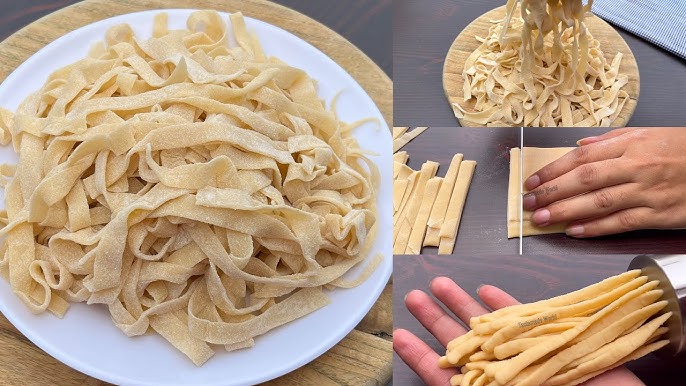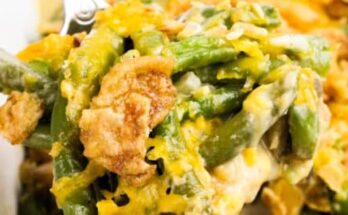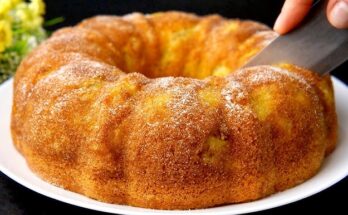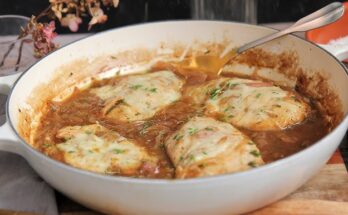Fresh Pasta Dough Recipe: There’s something magical about fresh pasta dough. The silky, tender texture is unlike anything you’ll ever find in a box of dried pasta. Making pasta from scratch is not just cooking—it’s an experience, a tradition that connects you with centuries of Italian heritage. Whether you’re crafting spaghetti for a simple tomato sauce or rolling out wide sheets for lasagna, fresh pasta transforms any dish into a comforting masterpiece.
This guide will take you through everything you need: ingredients, tools, and a clear step-by-step process. By the end, you’ll know how to make pasta like a pro in your own kitchen.
Introduction to Homemade Pasta Dough
Why do people rave about fresh pasta? The answer lies in both taste and texture. Store-bought dried pasta, while convenient, often lacks the soft, delicate bite that freshly made pasta offers. Homemade pasta has a rich, eggy flavor, and it absorbs sauces beautifully, making every bite irresistible.
Another reason to try homemade pasta is control. You get to decide the ingredients, the thickness of the dough, and even add colors and flavors like spinach or beetroot. Plus, making pasta can be therapeutic. Kneading dough by hand, rolling it out, and cutting it into shapes gives a sense of craftsmanship that’s missing when you simply open a package.
The best part? You don’t need to be a professional chef to master pasta making. With a little patience and practice, anyone can do it. This guide breaks it down into simple steps so you can confidently create pasta dough from scratch.
Ingredients You’ll Need
The heart of any good pasta recipe lies in its ingredients. Unlike complex dishes that require long shopping lists, pasta dough needs only a few essentials. But don’t let the simplicity fool you—the quality of each ingredient makes a world of difference.
Essential Ingredients
- Flour – The foundation of pasta dough. Traditional Italian pasta is made with “00” flour, which is finely milled and creates a smooth, silky dough. However, all-purpose flour works perfectly fine and gives the pasta a slightly firmer texture. For a rustic feel, you can also use semolina flour, which adds a bit of bite.
- Eggs – Fresh eggs bring richness, color, and elasticity to the dough. The general rule is one egg per 100 grams of flour, but some recipes add extra yolks for a golden color and richer taste.
- Olive Oil – A drizzle of olive oil isn’t mandatory, but it enhances the dough’s flexibility and adds a subtle flavor.
- Salt – Just a pinch is enough. Salt enhances the overall taste but shouldn’t overpower the natural flavor of the pasta.
Optional Additions for Flavor
If you’re feeling adventurous, pasta dough is an excellent canvas for creativity:
- Herbs – Freshly chopped basil, parsley, or oregano can be kneaded into the dough for a fragrant twist.
- Vegetables – Spinach, beetroot, or even squid ink can give your pasta a vibrant color while adding unique flavors.
- Infused Oils – Garlic or chili-infused olive oil can subtly transform the dough’s taste profile.
The key is balance. Don’t overload your dough with too many additions—sometimes, less is more when it comes to pasta.
Tools and Equipment for Perfect Pasta Dough
Can you make pasta with nothing more than your hands and a rolling pin? Absolutely. Italians have been doing it for centuries. But in today’s kitchens, having the right tools can save you time and effort.
Traditional Tools
- Wooden Board – Rolling pasta on wood creates slight friction, helping the dough stretch without slipping.
- Rolling Pin – A long, sturdy rolling pin is essential for evenly flattening the dough by hand.
- Knife or Bench Scraper – Useful for cutting pasta shapes and keeping your workspace clean.
Modern Kitchen Tools
- Stand Mixer with Dough Hook – If kneading by hand feels intimidating, a stand mixer makes the job much easier and quicker.
- Pasta Machine – This is a game-changer. A manual pasta machine with rollers helps achieve even thickness and consistency. You can also attach pasta-cutting accessories for different shapes.
- Bench Scraper – Not only handy for dividing dough but also for scooping flour off your counter.
Having these tools isn’t mandatory, but they make the process smoother and more enjoyable, especially if you plan to make pasta regularly.
Step-by-Step Guide to Making Fresh Pasta Dough
Now we’re ready for the real magic—the process of transforming flour and eggs into smooth, elastic pasta dough.
Step 1: Measure and Prepare Ingredients
Start with precision. For a standard serving, measure about 100 grams of flour and 1 egg per person. Create a clean workspace, ideally on a large wooden board or countertop. Having everything ready makes the process smoother.
Step 2: Forming the Flour Well
Pour your flour into a mound and make a well in the center, like a little volcano. This classic Italian technique keeps your eggs contained and makes mixing easier.
Step 3: Mixing Eggs into the Flour
Crack your eggs into the well and beat them lightly with a fork, gradually pulling flour from the sides until the mixture thickens into a sticky dough.
Step 4: Kneading the Dough
Kneading is where the magic happens. Press the dough with the heel of your hand, fold it, turn it, and repeat for about 8–10 minutes until it’s smooth and elastic. If it’s too sticky, sprinkle a bit more flour; if too dry, add a drop of water.
Step 5: Resting the Dough
Wrap the dough in plastic wrap and let it rest at room temperature for at least 30 minutes. This allows the gluten to relax, making it easier to roll out later.
This resting step is non-negotiable. Skip it, and your dough will fight you when rolling.
Rolling and Shaping Fresh Pasta
Once your dough has rested, it’s time to transform it into beautiful sheets and strands of pasta. This stage is where your creativity comes alive—whether you want silky lasagna sheets, delicate tagliatelle, or rustic hand-cut fettuccine, the possibilities are endless.
Rolling by Hand
Rolling pasta by hand requires patience and a bit of muscle, but it’s rewarding. Start by cutting your dough into smaller portions to make it more manageable. Flatten one piece slightly with your hands, then use a rolling pin to stretch it out. Always roll from the center outwards, rotating the dough often to maintain an even thickness. The goal is to get the dough thin enough that you can almost see your hand through it.
Hand-rolled pasta often has a rustic texture that clings beautifully to sauce. It might not be perfectly uniform, but that’s part of its charm. If you enjoy the tactile experience of cooking, this method gives you a true artisan feel.
Using a Pasta Machine
If precision and ease are what you’re after, a pasta machine is your best friend. Feed the dough through the rollers, starting at the widest setting. Fold the dough in half and run it through again, repeating this process a few times to build elasticity. Gradually reduce the thickness setting until your pasta sheet is thin, smooth, and silky.
Most machines also come with cutters for spaghetti, tagliatelle, or fettuccine. This ensures even shapes that cook uniformly. The key here is patience—don’t rush to the thinnest setting immediately, or your dough may tear.
Cutting Pasta into Shapes
Once your sheets are ready, you can cut them into whatever shape you like:
- Fettuccine – Wide ribbons perfect for creamy sauces.
- Tagliatelle – Slightly narrower than fettuccine, ideal for meaty ragùs.
- Lasagna Sheets – Large flat pieces for layering with sauce and cheese.
- Pappardelle – Extra-wide ribbons, perfect for rich, hearty sauces.
Dust your pasta with flour to prevent sticking, and place the cut pieces in little nests until you’re ready to cook.
Cooking Fresh Pasta
Cooking fresh pasta is a completely different experience from boiling dried pasta. The cooking time is much shorter, and the payoff is a tender, silky texture that elevates any dish.
How Long to Boil Fresh Pasta
Fresh pasta cooks in just 2–3 minutes. Yes, that’s all it takes! The moment the pasta floats to the top of the boiling water, it’s ready. Overcooking fresh pasta will make it mushy, so keep a close eye on it.
Be sure to use a large pot of well-salted water. Italians often say the water should be “as salty as the sea.” This step seasons the pasta from the inside out.
Tips for Perfect Texture
- Use plenty of water – This prevents sticking and ensures the pasta cooks evenly.
- Stir gently – Fresh pasta is delicate, so give it a gentle stir right after adding it to boiling water.
- Save pasta water – Before draining, scoop out a cup of starchy pasta water. This liquid gold helps sauces cling to the pasta beautifully.
Common Mistakes to Avoid
- Overcooking – The number one mistake. Taste test frequently.
- Not salting the water – Unsalted water makes bland pasta.
- Rinsing pasta – Never rinse fresh pasta after cooking. This washes away the starch that helps sauce stick.
Storing and Preserving Fresh Pasta
What if you’ve made a big batch and can’t eat it all at once? Good news—fresh pasta stores well if handled properly.
Refrigerating Pasta Dough
Wrapped tightly in plastic wrap, pasta dough can rest in the fridge for up to 2 days. Any longer, and it may start to discolor. Always bring it back to room temperature before rolling.
Freezing Fresh Pasta
Freshly cut pasta can be frozen for up to 2 months. Simply dust it with flour, shape into nests, and place on a tray in the freezer until firm. Once frozen, transfer to a container or freezer bag. When you’re ready to use it, drop it straight into boiling water—no need to thaw.
Drying Pasta for Long-Term Storage
If you prefer shelf-stable pasta, drying is the way to go. Lay your pasta out on drying racks or even a clean kitchen towel, ensuring the strands don’t overlap. Once fully dry, it can be stored in airtight containers for months. This method is especially useful for long shapes like spaghetti or linguine.
Serving Suggestions and Pairings
Fresh pasta is delicious on its own, but the right sauce and pairings take it to the next level.
Best Sauces for Fresh Pasta
- Simple Tomato Sauce – A classic, light pairing that lets the pasta shine.
- Alfredo or Cream Sauces – Perfect for fettuccine, adding richness and depth.
- Pesto – Fresh basil pesto clings beautifully to tagliatelle or linguine.
- Meat Ragù – Traditional Bolognese is the ultimate match for tagliatelle.
Wine Pairings
Pairing wine with fresh pasta elevates the dining experience:
- Tomato-based sauces pair well with medium-bodied reds like Chianti.
- Creamy sauces complement buttery Chardonnays.
- Pesto shines with crisp white wines such as Sauvignon Blanc.
Classic Italian Combinations
- Tagliatelle with ragù alla Bolognese.
- Lasagna sheets layered with béchamel and meat sauce.
- Ravioli filled with ricotta and spinach, served with sage butter.
Serving fresh pasta is all about balance—light pasta deserves a light sauce, while hearty pasta works best with robust flavors.
Tips and Tricks for Perfect Pasta Every Time
Even the most seasoned cooks face challenges when making pasta. Here are some pro tips to help you nail it every time.
Common Problems and How to Fix Them
- Dough too sticky? Add a sprinkle of flour while kneading.
- Dough too dry? Drizzle in a drop of water or olive oil.
- Pasta tearing while rolling? Let it rest longer to relax the gluten.
Chef’s Secrets for Extra Flavor
- Use farm-fresh eggs for brighter color and richer taste.
- Blend 00 flour with semolina for a balance of softness and bite.
- Add herbs directly into the dough for subtle flavor notes.
- Cook pasta al dente—it should still have a slight chew.
Making pasta may seem intimidating at first, but once you understand these little tricks, it becomes second nature.
Nutritional Value of Fresh Pasta Dough
Fresh pasta is more than just delicious—it also brings a good balance of nutrients to the table. While it’s not the lightest food, when eaten in moderation, it can be part of a wholesome diet.
A basic pasta dough made with flour and eggs is naturally rich in carbohydrates, which provide energy, and proteins, which contribute to muscle repair and satiety. The eggs in the dough add healthy fats, vitamins like B12, and minerals such as iron and zinc. Compared to dried pasta, fresh pasta has slightly more protein and fat due to the higher egg content, giving it a richer nutritional profile.
If you use “00” flour, your pasta will be lighter and lower in fiber, while whole wheat flour adds more fiber and micronutrients but creates a denser texture. Adding ingredients like spinach or beetroot doesn’t just enhance color and flavor—it also sneaks in extra vitamins and antioxidants.
Here’s a simple breakdown (per 100g of fresh pasta dough):
| Nutrient | Amount (approx.) |
|---|---|
| Calories | 288 kcal |
| Carbohydrates | 55 g |
| Protein | 10 g |
| Fat | 3.5 g |
| Fiber | 2 g |
Fresh pasta is filling and satisfying, so you don’t need to overeat to feel content. Paired with fresh vegetables and light sauces, it can be both indulgent and nutritious.
Gluten-Free and Vegan Alternatives
Not everyone can enjoy traditional pasta, but the beauty of homemade dough is that it’s adaptable. With a few tweaks, you can make pasta that suits dietary needs without sacrificing taste.
Gluten-Free Pasta Dough
For gluten-free pasta, regular wheat flour is replaced with alternatives like rice flour, chickpea flour, or a blend of gluten-free flours. To mimic the elasticity that gluten provides, xanthan gum or psyllium husk is often added. This makes the dough more pliable and easier to roll without crumbling.
The texture will be slightly different—more delicate and sometimes less stretchy—but with practice, gluten-free pasta can be just as delicious. It pairs especially well with lighter sauces that won’t overwhelm the softer texture.
Vegan Pasta Dough
Traditional pasta uses eggs, but vegan versions are simple and tasty. Instead of eggs, water and olive oil are used to bind the flour. Some recipes include semolina flour, which helps create structure and chewiness. For extra richness, some cooks add pureed vegetables like pumpkin or beetroot, which add both moisture and color.
Vegan pasta is surprisingly versatile and can be rolled, cut, and shaped just like traditional dough. While it may lack the golden hue of egg pasta, it’s equally satisfying, especially when paired with bold sauces like arrabbiata or roasted vegetable ragù.
FAQs about Fresh Pasta Dough Recipe
Q1: Can I flavor pasta dough with spices like garlic or chili powder?
Yes! Adding spices directly into the flour gives the dough subtle, built-in flavors. Just don’t overdo it—keep the balance gentle.
Q2: How thin should I roll pasta sheets for lasagna?
Aim for about 1–2 mm thick. Too thick, and it will feel heavy; too thin, and it might tear when layering.
Q3: Is fresh pasta healthier than dried pasta?
Fresh pasta often has more protein and fat because of the eggs, while dried pasta usually has fewer calories. Both can be healthy depending on portion size and what you serve them with.
Q4: Can I make pasta without eggs entirely?
Yes! You can make egg-free pasta using water and flour (common in southern Italy). It’s lighter and has a slightly different texture but still delicious.
Q5: What sauces should I avoid with fresh pasta?
Avoid overly heavy sauces that overpower the delicate flavor of fresh pasta. Stick to lighter, fresh sauces for the best results.
Conclusion
From rolling and cutting to cooking and pairing with sauces, the entire journey is hands-on and deeply satisfying. The best part? Every batch you make tells a story—whether it’s a family dinner, a romantic meal, or a weekend experiment, fresh pasta has a way of bringing people together.
So, grab your flour, crack those eggs, and start kneading. Once you taste the difference, there’s no going back to store-bought pasta.



